Translate this page into:
Communicating Care in Digital Social Spaces: Mixed-method Analysis of Influence of Social Media on Palliative Care
*Corresponding author: Dr Kriti Singh, Associate Professor, Amity School of Communication, Amity University Noida and Post-Doctoral Scholar, Manipur International University, Manipur, India. ksingh21@amity.edu
-
Received: ,
Accepted: ,
How to cite this article: Singh K. Communicating Care in Digital Social Spaces: Mixed-method Analysis of Influence of Social Media on Palliative Care. Indian J Palliat Care 2024;30:189-99. doi: 10.25259/IJPC_338_2023
Abstract
The paper is based on mixed-methods analysis, including qualitative (thematic analysis) and quantitative (word frequency and trends analysis), to thoroughly investigate the existing body of literature pertaining to the influence of social media (SM) on palliative care (PC). The time frame of the analysis is for a 5-year (2018–2023). The paper attempts to explore dominating themes and explore how SM has impacted the arena of palliative, how these platforms affect patient and community involvement and how successful digital communication tactics are when used to advocate for PC.
Keywords
Palliative care awareness
social media
Palliative awareness healthcare
public perception of palliative care
Health communication
Sustainable development goal 17 and healthcare
INTRODUCTION
Social media (SM) has a significant and wide-ranging impact on how the general public views healthcare concerns in the modern digital age. This paper explores the complex relationship between SM and the general public’s awareness of palliative care (PC), a field that is often misinterpreted and not adequately represented in mainstream discussions. This paper attempts to elucidate the impact of SM on the formation, reinforcement, or challenge of public perceptions of PC. The study employs a mixed-methods approach, incorporating both qualitative (thematic analysis) and quantitative (word frequency and trend analysis) methods, to examine existing literature on the influence of social media from 2018 to 2023. It makes an effort to provide valuable insights discussed in academia into how SM platforms influence and shape public opinions on PC. This investigation is crucial for comprehending how digital communication might be efficiently utilised to improve public knowledge and backing for PC, finally leading to improved healthcare results and educated public discussion. The paper will attempt to answer the following questions.
Q1: What are the dominant themes and prominent word trends observed in academic research regarding the role of SM in PC?
Q2: How do these thematic and lexical patterns impact the comprehension and spread of PC information among experts and the general public, particularly during significant health crises like as the COVID-19 pandemic?
Research objectives
The objective of the review is to examine the existing body of literature on SM and PC and the frequency of words in scholarly works discussing the utilisation of SM in PC. It will also attempt to evaluate the impact of SM on public and professional attitudes, methods and regulations in PC. It will also comprehensively analyse the impact of SM on PC using a combination of qualitative and quantitative methodologies, combining thematic analysis with word frequency and trend analysis. It will also try to assess the efficacy of SM as a tool of health communication (Health Commun) and educational tool in the domain of PC.
METHODS
This literature review used mixed methods, that is, the combination of qualitative and quantitative methods, to evaluate the impact of SM on PC. The time frame for the selection of the literature pertaining to SM was from 2018 to 2023.
Data sources and search strategy
Academic databases such as PubMed, National Library of Medicine, Scopus, Academia.edu and Google Scholar were utilised. Relevant phrases encompass ‘palliative care’ and ‘social media’ terminology were used. The search was restricted to English items published within the timeframe.
Inclusion and exclusion criteria
The inclusion criteria consisted of peer-reviewed works published in English within a specific period, with a focus on the study’s main issue. The exclusion criteria encompassed articles that are inaccessible due to paywalls, papers written in languages other than English, and those that are not directly relevant to the relationship between SM and PC. Studies meeting the requirements of focusing on PC and SM were included, while studies that are not relevant or have poor methodological quality were excluded from the study.
Themes generation
The process of thematic analysis began with an initial examination and classification of the articles to identify preliminary themes. Subsequently, a thorough analysis and improvement of these concepts were conducted, guaranteeing a sophisticated comprehension of how digital media influenced public opinions and conversations on PC. The objective of this approach was to generate a comprehensive, empirically supported analysis of the contribution of digital HealthCom to palliative care awareness.
Quality assessment
The mixed-methods appraisal tool (MMAT) will be used to assess the methodological quality of the chosen studies.
Data analysis
Qualitative data will undergo thematic analysis, while quantitative data will be subjected to word frequency and trend analysis to uncover prominent themes and trends.
RESULTS
Thematic analysis
Following are the major themes identified in the papers reviewed with visualisation [Table 1]:
| S. No. | Paper title | Themes identified |
|---|---|---|
| 1. | The Emerging Use of SM for Health-related Purposes in LMICs: A Scoping Review by Hagg et al.[1] | SM in health awareness in LMICs: The paper explores the use of SM in LMICs to spread health-related information and shape public health behaviours. SM’s role in infectious disease management: This paper examines the impact of SM in managing and disseminating information during infectious disease epidemics. SM in disaster and crisis response examines the use of SMPs for communication and coordination in the context of natural disasters, terrorism, crises, and emergencies. Challenges with SM health misinformation: It provides the analysis of the issues associated with disinformation in health-related content on SM, as well as the perception and interaction of consumers with this information. 
|
| 2. | The Impact of Public Health Awareness Campaigns on the Awareness and Quality of PC by Seymour,[2] | SM Campaigns’ effectiveness in PA: The paper evaluates the efficacy of public health campaigns in enhancing knowledge of PC via SMPs. SM to inform the public and professionals: It underscores the use of SM strategies to involve the public and actively provide information about PC. SM in PC advocacy: It examines the role of SM within the context of broader social marketing and mass media techniques in advocating for PC. SM in culturally sensitive PC messaging: It explains the significance of employing a culturally appropriate SM message to engage different populations effectively. SM’s impact on palliative quality: It discusses the influence of SM-driven public awareness on improving the calibre of PC services. 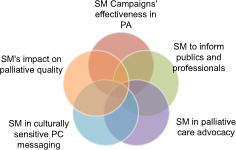
|
| 3. | Exploring the Use of SM by Adolescents and Young Adults with Life Limiting/Threatening Conditions: An Integrative Review by Peat et al.[3] | SM influences youth content sharing: The paper discusses SM’s impact on the selection of platforms and the material shared by teenagers and young adults with life-threatening diseases. SM empowers through shared narratives: It highlights how SM serves as a platform for individuals to interact with others who have similar experiences, fostering empowerment and facilitating the sharing of personal stories. Barriers to youth SM usage: It discusses the challenges to using SM, such as concerns about accuracy and the psychological impacts it may have. 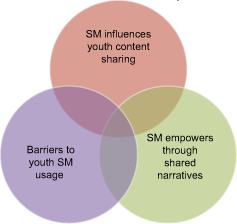
|
| 4. | PC Research Centre’s Move into SM: Constructing a Framework for Ethical Research by Hopewell-Kelly, et al.[4] | Ethics in SM Data for PC Research: The paper explores the ethical consequences of utilising SM data in PC research, with a particular focus on the importance of adhering to ethical principles. Public versus Private Internet Data in SM: It discusses the differentiation between public and private data on SMP, emphasising the complexities involved in deciding the criteria publicly accessible information. Open versus Closed Groups’ Data Ethics in SM Groups: It explores the ethical dilemmas associated in using data from both open and closed SM groups for research in PC. Challenges Using Historical SM Data in PC Research: It investigates into the complexities involved in using historical SM data, due to dynamic nature of SM data. Digital Consent in PC Research: It discusses the specific challenge in finding volunteers and getting informed permission for studies carried out on SM. Anonymity in Online PC Studies: It highlights the relevance of preserve participant confidentiality and identity protection when sharing research findings online. 
|
| 5. | Ethical Considerations for Participatory Health through SM: Healthcare Workforce and Policy Maker Perspectives by Rivera-Romero, et al.[10] |
Ethical Dilemmas in Participatory Health via SM: The paper explores the intricacies of ethical issues related to the use of SM for participatory health, with particular attention to digital literacy, security and data protection. Diverse Stakeholders’ Ethical Perspectives: It draws attention to the diverse viewpoints of various healthcare stakeholders, such as professionals, patients, IT specialists and legislators, regarding the moral issues raised by SM in the medical field. SM Health Data Privacy, Security: It underscores the sensitivity of ‘health information' and highlights the importance of data privacy and security in health-related use of SM. Quality Assurance in Health Information: It discusses the importance of verifying health information shared and consumed through SM. SM’s Evolving Healthcare Ethical Impact: It sheds light on the changing role of SM in healthcare and how it raises new ethical issues, demands updated norms and ethical frameworks. 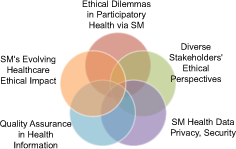
|
| 6. | Mining Twitter to Assess the Determinants of Health Behaviour towards PC in the United States by Zhao, et al.[12] | Examining PC Perceptions on Twitter: The paper evaluates the extent to which Twitter matches the public’s awareness and views regarding PC. Twitter Data Reveals Health Behaviours: It discusses how Twitter data are used collect information about health behaviours and factors associated with PC. Twitter’s Impact on Health Commun: It analyse the impact of Twitter debates on public health behaviours and awareness, focusing on the role of SM in Health Commun. Difficulty in Methodological Extracting Twitter Data: It explores the difficulties and approaches involved in obtaining and analysing SM data for research on health behaviour. 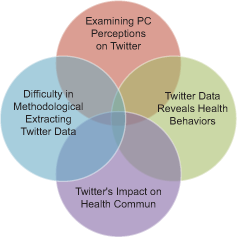
|
| 7. | Stakeholder Engagement in Research on Quality of Life and PC for Brain Tumours: The Brain Cancer Quality of Life Collaborative engaged with the brain tumor (#BTSM) and palliative medicine (#HPM) stakeholder communities through tweet chats on Twitter by Salmi, et al.[13] |
QoL Diversity in Brain Tumour PC: The paper highlighted that the SM discussions regarding brain tumour patients’ physical, cognitive and psychosocial QoL. PC Communication Enhanced by SM: It underscored that the SM helps patients, carers and health professionals discuss PC. Diverse Stakeholders’ Perspectives through SM: It discussed that SM allows many stakeholder groups to contribute their brain tumour and PC perspective Effective Stakeholder Engagement in PC: It highlighted that the Twitter conversations’ ability to engage a wide spectrum of stakeholders in PC and brain tumour patient QoL issues. 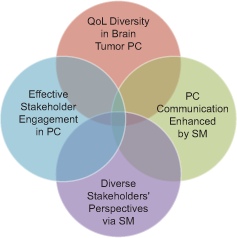
|
| 8. | Physicians’ Knowledge about PC in Bangladesh: A Cross-sectional Study using Digital SMPs by Biswas, et al.[8] | Evaluating Physicians’ PC Knowledge: The paper assessed the general understanding and misconceptions of PC among physicians Identifying Misconceptions in PC: It identifies physician misconceptions about PC, particularly its scope and patient eligibility. Physician Demographics Influence Knowledge Levels: It examined the association between physicians’ demographics and PC knowledge. SM as a Research Tool: It introduces SMPs as a useful research tool in reaching out to and involving physicians. 
|
| 9. | Disseminating PC Education to Chinese Americans through SM By Kuang and Woo,[5] | ACP Challenges in Elderly Chinese Americans: The paper focuses on the issue of limited participation in ACP as a result of language obstacles and insufficient cultural adjustment. SM for PC Education: It explores the use of SM channels to efficiently distribute PC knowledge to the Chinese American population. |
Analysing Chinese Americans’ SM Engagement: It examines the ways in which the Chinese-speaking population interacts with PC knowledge on different SM channels.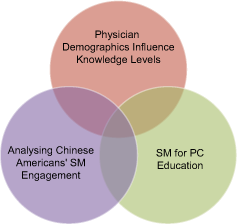 |
||
| 10. | Health Professionals’ Perspectives of the Role of PC During COVID-19: Content Analysis of Articles and Blogs Posted on Twitter by Singh, et al.[6] | SM unites Professionals in PC: During the COVID-19 pandemic, SM opinion pieces and blogs have helped professionals connect, share knowledge and encourage one other. PC’s Role in COVID-19: The paper highlighted the crucial role of PC in the response to COVID-19. PC as a global obligation: It emphasised on the necessity for all healthcare practitioners to possess fundamental PC competencies. Specialist Palliative guidance during pandemics: The necessity of PC teams with expertise to provide guidance to other healthcare providers. Using Twitter for engagement: Employing Twitter to collect and analyse the viewpoints and experiences of health professionals. 
|
| 11. | How Blogs Support the Transfer of Knowledge into Practice in the Field of Dementia PC: A Survey of Facilitators and Barriers by Rukundo, et al.[11] | Blogs Facilitate Dementia PC Knowledge: The paper investigates the use of blogs to spread knowledge in the field of dementia PC. Healthcare’s Perception of Blogs’ Utility: It analyses how medical practitioners and scholars use PC blogs. Identifying Blog Engagement Drivers, Barriers: It examines the factors that motivate or impede healthcare workers in their use of blogs. Expanding dementia PC info through SM: It examines the SM’s role in dementia PC information transmission. It discusses how SM tools like blogs may spread information in this filed. SM as educational tools to advance PC practices: It highlighted how blogs and SM can be used as educational tools to advance PC practices among healthcare professionals, with special reference to dementia care. 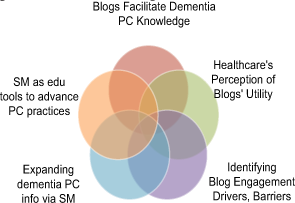 |
| 12. | PC TikTok: Describing the Landscape and Explaining SM Engagement by Easwar, et al.[8] | PC portrayal on TikTok: The paper examines how PC is represented and deliberated on TikTok. Analysing User Engagement in Palliative TikTok: It analyses the key attributes related to with increased user engagement (views, likes, comments and shares) on PC-related TikTok videos. TikTok: Author Types and Themes: It examines the prevalent categories of writers, namely healthcare professionals, patients and carers, as well as the recurring topics seen in these films, such as personal stories, education and debunking misunderstandings. TikTok as Interactive PC Platform: TikTok is highlighted as an interactive platform in the paper wherein individuals requiring PC, including patients, specialists and carers, can share their own stories and content. 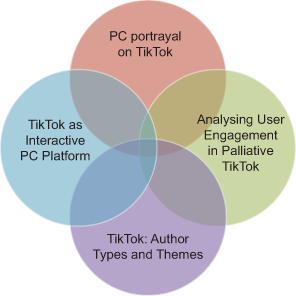
|
| 13. | Public Opinions About Palliative and End-of-Life Care During the COVID-19 Pandemic: Twitter-Based Content Analysis by Wang, et al. (2023)[9] |
Public discourse of PEoLC on Twitter: The paper analyses at how the public used Twitter during the COVID-19 epidemic to address topics pertaining to PEoLC, with a particular emphasis on cancer care and medical facilities. Twitter Reflects Personal PEoLC Stories: It discusses personal narratives shared by Twitter users, exhibiting the collective sentiment and first-hand encounters related to PEoLC. Vaccines Impacting PEoLC Twitter Debates: It examines the impact of COVID-19 immunisation programmes on public discourse regarding end-of-life care (PEoLC) on Twitter. SM Captures PEoLC Perspectives in Crisis: It highlights the significance of SM in documenting immediate public sentiments and encounters concerning PEoLC in the midst of an acute health emergency. 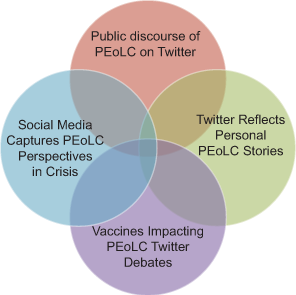
|
SM: Social media, PA: Palliative awareness, PC: Palliative care, LMICs: Low- and middle-income countries, SMP: Social media platforms, QoL: Quality of life, ACP: Advance care planning
GRAPHIC VISUALISATION OF QUANTITATIVE DATA
Word cloud and word trend
The paper utilises a combination of thematic analysis and word frequency trends analysis to examine the impact of SM on PC. Trend analysis in academic research involves identifying commonly utilised words, which offers valuable insights into the dominant subjects and themes present in the literature. These patterns are employed to comprehend the influence of SM on public and expert viewpoints on PC. The importance of these word patterns regarding the study’s conclusions lies in their connection to the prevailing discourse and areas of emphasis within the field. They provide vital insights into how SM is influencing the narrative and comprehension of PC. Following is the single paper’s quantitative data visualization, featuring a Word Cloud and Word Trends analysis [Table 2].
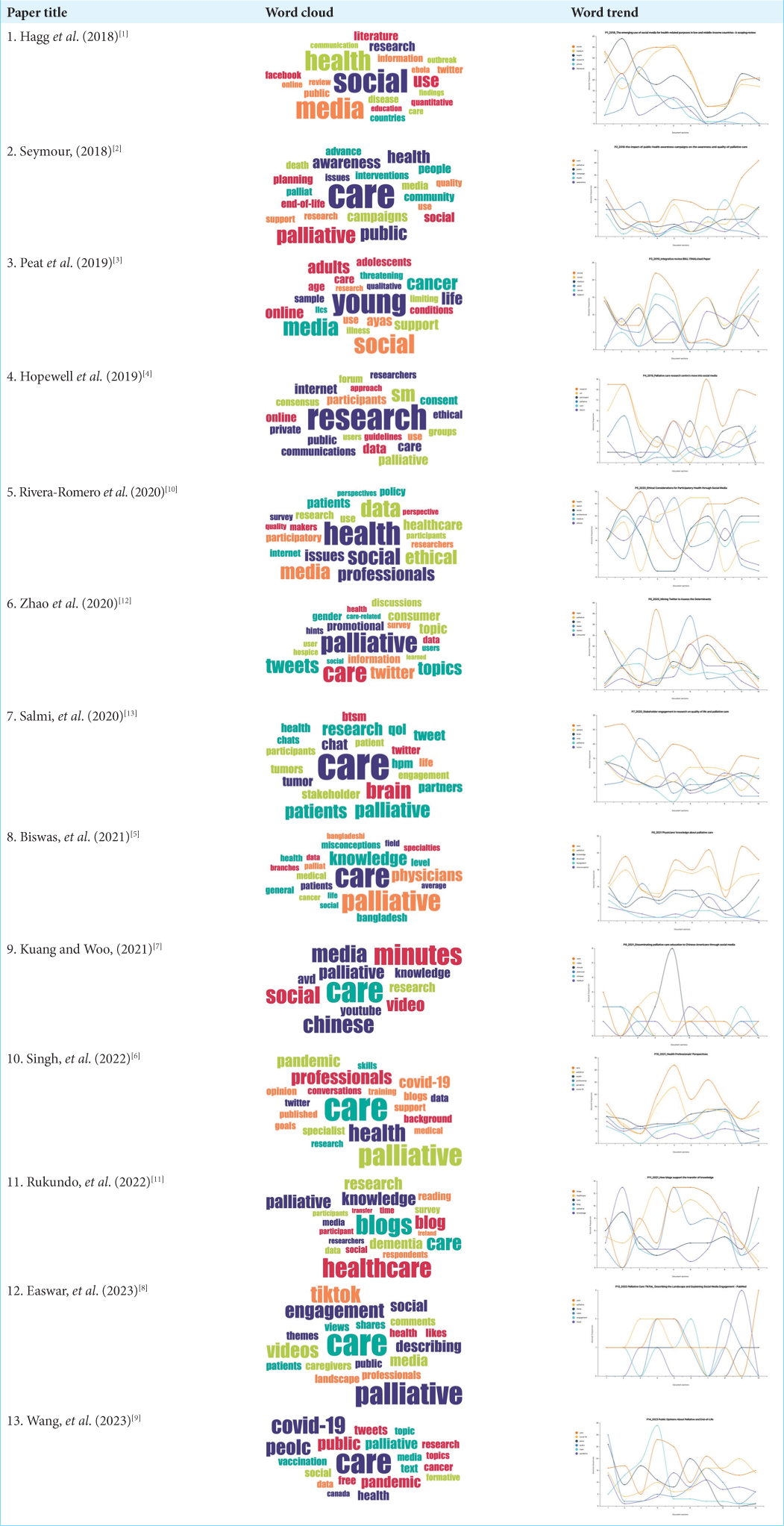 |
The following figure illustrates the representation of strongly interconnected themes, highlighting the relationships and patterns within the data [Figure 1].

- Representation of strong interconnected themes
DISCUSSION
Increasing role of SM in PC
Studies by Hagg et al. (2018), Seymour (2018)[1,2] and others emphasised the escalating impact of SM in enhancing public consciousness and instruction regarding PC. This phenomenon is especially noticeable in nations with poor and intermediate incomes, as well as among specific population groups, such as teenagers and young adults who are afflicted with chronic diseases (Peat et al., 2019).[3]
Challenges of misinformation and ethical on SM channels
The widespread problem of disinformation on SM platforms, as examined in studies conducted by Hopewell-Kelly et al. (2019), presents substantial difficulties in the realm of PC communication. Moreover, ethical considerations, particularly pertaining to privacy and permission, are of utmost importance when it comes to the distribution of PC material on the Internet.[4]
Educating and engaging healthcare professional in using SM for PC
Biswas et al. (2021) and Singh et al. (2022)[5,6] highlight the importance of teaching and involving healthcare professionals in utilising SM for PC, especially in times of emergency like as the COVID-19 pandemic.
Sensitivity to cultural differences and accessibility
Kuang and Woo (2021) highlight the significance of culturally aware and language-specific materials in effectively reaching a variety of communities.[7]
SM platforms new possibilities for health Commun
The emergence of new SM platforms such as TikTok (Easwar et al., 2023) and their distinct patterns of user interaction provide new possibilities for communication in the field of PC.[8]
SM impact on public opinion and perception
Wang et al. (2023) illustrate how SM can mirror and influence public beliefs and perceptions around palliative and end-of-life care.[9]
Impact of SM on PC
The studies reviewed highlight the positive impacts of SM on both public and professional views concerning PC. Publicly, SM has broadened its accessibility to the people, promoted patient/community involvement and enhanced patient-provider communication. Singh et al. (2022) for example underscored the role of PC in palliating clinical uncertainty during the COVID-19 pandemic while similarly supporting complex decision-making process.[6]
Word frequency and trends analysis
An examination of word frequencies in a document shows that terms like ‘awareness’, ‘education’ and ‘advocacy’ are very common suggesting that a lot attention is being paid to getting people involved through information dissemination projects. Kuang and Woo (2021)[7] echo this observation when they indicate that using internet-based channels such as YouTube for teaching patients about PC has resulted in increased understanding and involvement of Chinese Americans (Kuang and Woo, 2021).[7]
Efficacy of SM as a tool of health commun
The reviewed articles consistently cited the efficacy of SM as a powerful tool for health communication. Easwar et al. (2023) pointed out that TikTok videos crafted by medical practitioners and support people succeeded in pulling together the community; in particular, it was disclosed that videos narrating people’s lives and informative presentations gained the most likes.[8]
The aforementioned studies collectively highlight the diverse range of effects that SM has on PC, encompassing aspects such as professional engagement, ethical deliberation and education and awareness. They emphasise both the advantages and difficulties of utilising SM platforms for efficient communication in PC. The following table presents the combined papers’ quantitative data visualization, generated using MAXQDA, showcasing the aggregated insights and trends across the datasets [Table 3].
 |
IMPLICATION, SIGNIFICANCE AND LIMITATION OF THE STUDY
The combined result of these studies uncovers noteworthy ramifications for the utilisation of SM in PC. It emphasises how effective SM platforms can be in raising awareness and educating people, along with the challenge of the fake information and the necessity for ethical consideration. Furthermore, the studies together indicate a change in the way PC information is conveyed and understood, highlighting the significance of cultural awareness and professional involvement. They also draw attention to certain drawbacks, such as the possibility of prejudice in SM information and its impact on various socioeconomic and cultural settings. The findings are noteworthy because they add to the changing field of health communication and provide guidance for future studies and SM and PC. In addition, the methodology of this study was assessed using the MMAT. The suitability and combination of mixed-methods, conclusions made, limitations and procedures for sampling, data collection and analysis were all taken into account while evaluating the study’s quality using the MMAT. The use of both qualitative and quantitative methodologies offered a comprehensive analysis; however, a few limitations regarding the ability to generalise of the sample were recognised. In general, the MMAT assessment affirms a strong and effective method with parts that could be refined. In addition, a limitation of the work is its dependence on English-language research conducted within particular academic databases. This selection may not comprehensively encompass the range of worldwide views on the topic.[10-13]
CONCLUSION
The review paper provided a mixed-methods analysis to evaluate the impact of SM on PC. It highlights major issues and lexical trends in scholarly research from 2018 to 2023, with an emphasis on the problems with misinformation, crisis management and health awareness with a focus on SM and PC. The paper highlights the influence of SM on public and professional perceptions of PC and evaluates its efficacy as a tool for health communication. The conclusion succinctly summarises the aforementioned findings, emphasising the growing significance of SM platforms in promoting awareness and education in PC. It also acknowledges the challenges and ethical concerns associated with this development.
Ethical approval
The Institutional Review Board approval is not required.
Declaration of patient consent
Patient’s consent was not required as there are no patients in this study.
Conflicts of interest
There are no conflicts of interest.
Use of artificial intelligence (AI)-assisted technology for manuscript preparation
The author confirms that there was use of artificial intelligence (AI)-assisted technology for assisting in the writing or editing, images of the manuscript and no images were manipulated using AI.
Financial support and sponsorship
Nil.
References
- The Emerging Use of Social Media for Health-related Purposes in Low and Middle-income Countries: A Scoping Review. Int J Med Inform. 2018;115:92-105.
- [CrossRef] [PubMed] [Google Scholar]
- The Impact of Public Health Awareness Campaigns on the Awareness and Quality of Palliative Care. J Palliat Med. 2018;21(Suppl 1):S30-6.
- [CrossRef] [PubMed] [Google Scholar]
- Exploring the Use of Social Media by Adolescents and Young Adults with Life Limiting/Threatening Conditions: An Integrative Review. BMJ Support Palliat Care. 2019;9:235-44.
- [CrossRef] [PubMed] [Google Scholar]
- Palliative Care Research Centre's Move into Social Media: Constructing a Framework for Ethical Research. BMJ Support Palliat Care. 2019;9:219-24.
- [CrossRef] [PubMed] [Google Scholar]
- Physicians' Knowledge about Palliative Care in Bangladesh: A Cross-sectional Study Using Digital Social Media Platforms. PLoS One. 2021;16:e0256927.
- [CrossRef] [PubMed] [Google Scholar]
- Health Professionals' Perspectives of the Role of Palliative Care During COVID-19: Content Analysis of Articles and Blogs Posted on Twitter. Am J Hosp Palliat Care. 2022;39:487-93.
- [CrossRef] [PubMed] [Google Scholar]
- Disseminating Palliative Care Education to Chinese Americans through Social Media. Int Psychogeriatr. 2021;33:843-4.
- [CrossRef] [PubMed] [Google Scholar]
- Palliative Care TikTok: Describing the Landscape and Explaining Social Media Engagement. J Palliat Med. 2023;26:360-5.
- [CrossRef] [PubMed] [Google Scholar]
- Public Opinions About Palliative and End-of-Life Care During the COVID-19 Pandemic: Twitter-Based Content Analysis. JMIR Form Res. 2023;7:e44774.
- [CrossRef] [PubMed] [Google Scholar]
- Ethical Considerations for Participatory Health through Social Media: Healthcare Workforce and Policy Maker Perspectives. Year Med Inform. 2020;29:71-6.
- [CrossRef] [PubMed] [Google Scholar]
- How Blogs Support the Transfer of Knowledge into Practice in the Field of Dementia Palliative Care: A Survey of Facilitators and Barriers. BMC Palliat Care. 2022;21:117.
- [CrossRef] [PubMed] [Google Scholar]
- Mining Twitter to Assess the Determinants of Health Behaviour towards Palliative Care in the United States. AMIA Jt Summits Transl Sci Proc. 2020;2020:730-9.
- [CrossRef] [Google Scholar]
- Stakeholder Engagement in Research on Quality of Life and Palliative Care for Brain Tumors: A Qualitative Analysis of #BTSM and #HPM Tweet Chats. Neurooncol Pract. 2020;7:676-84.
- [CrossRef] [PubMed] [Google Scholar]






